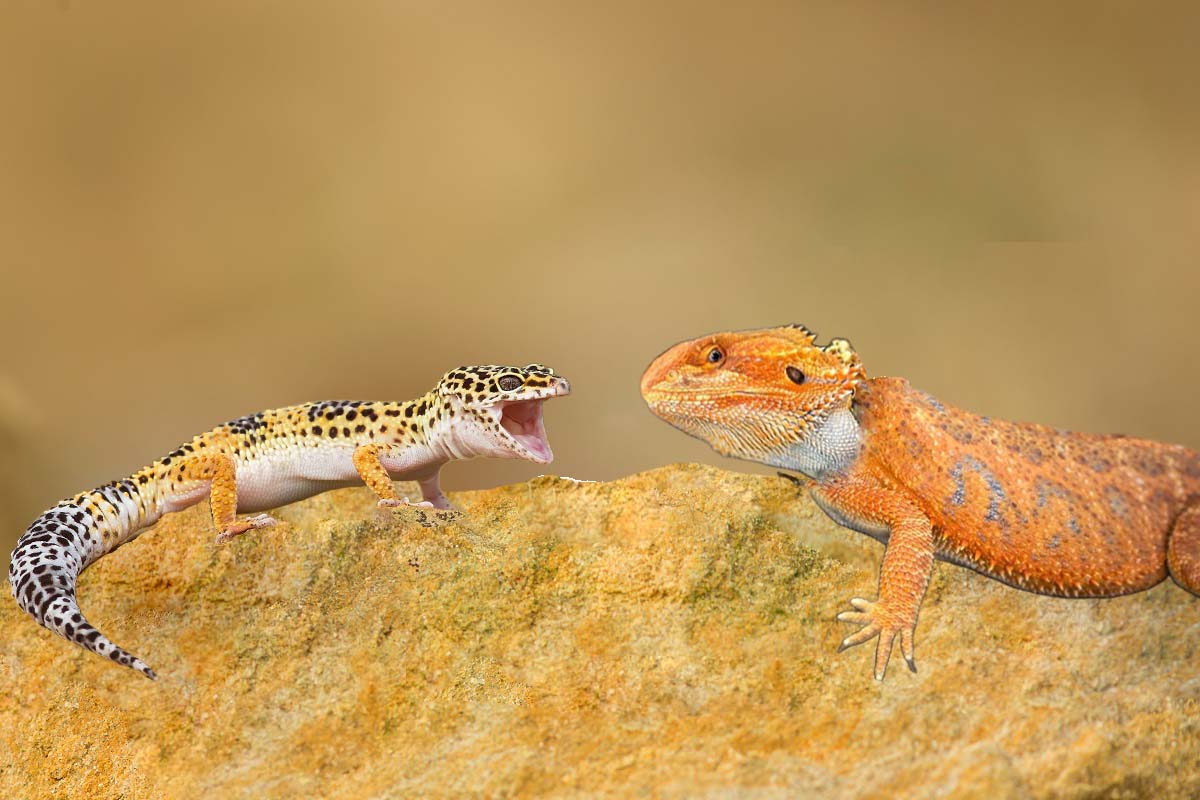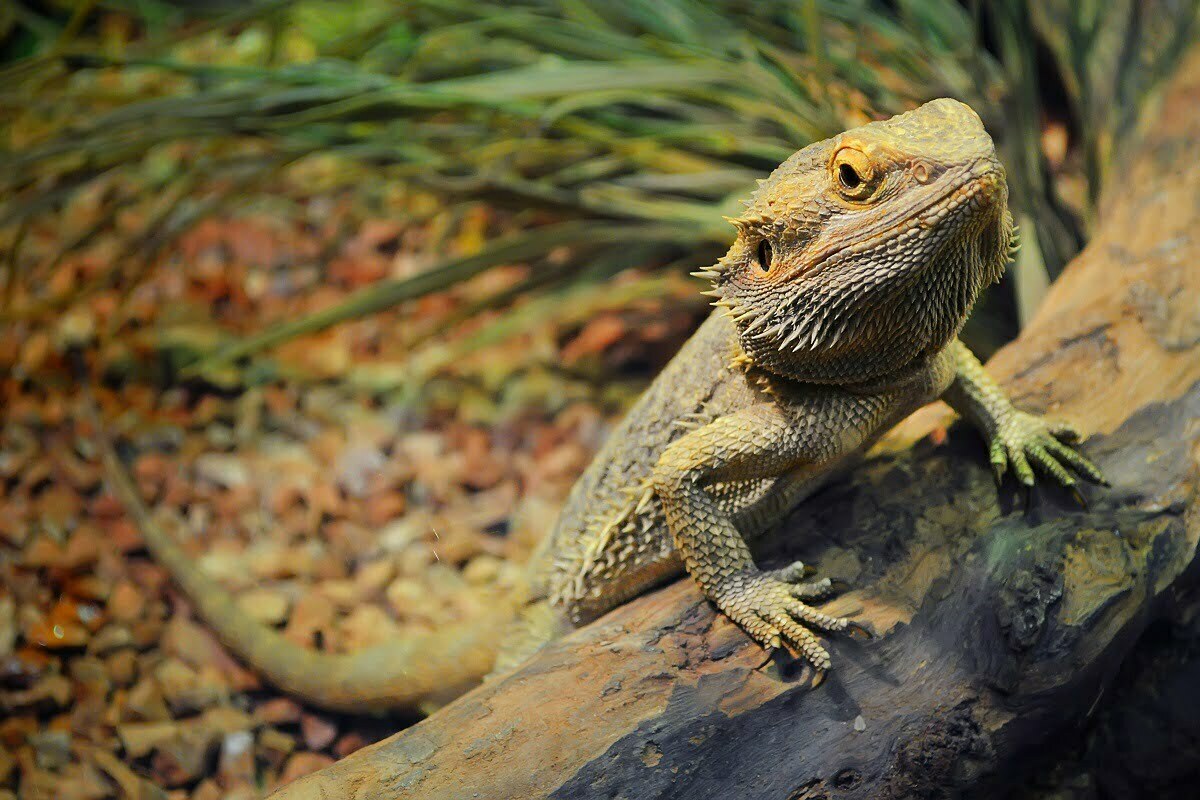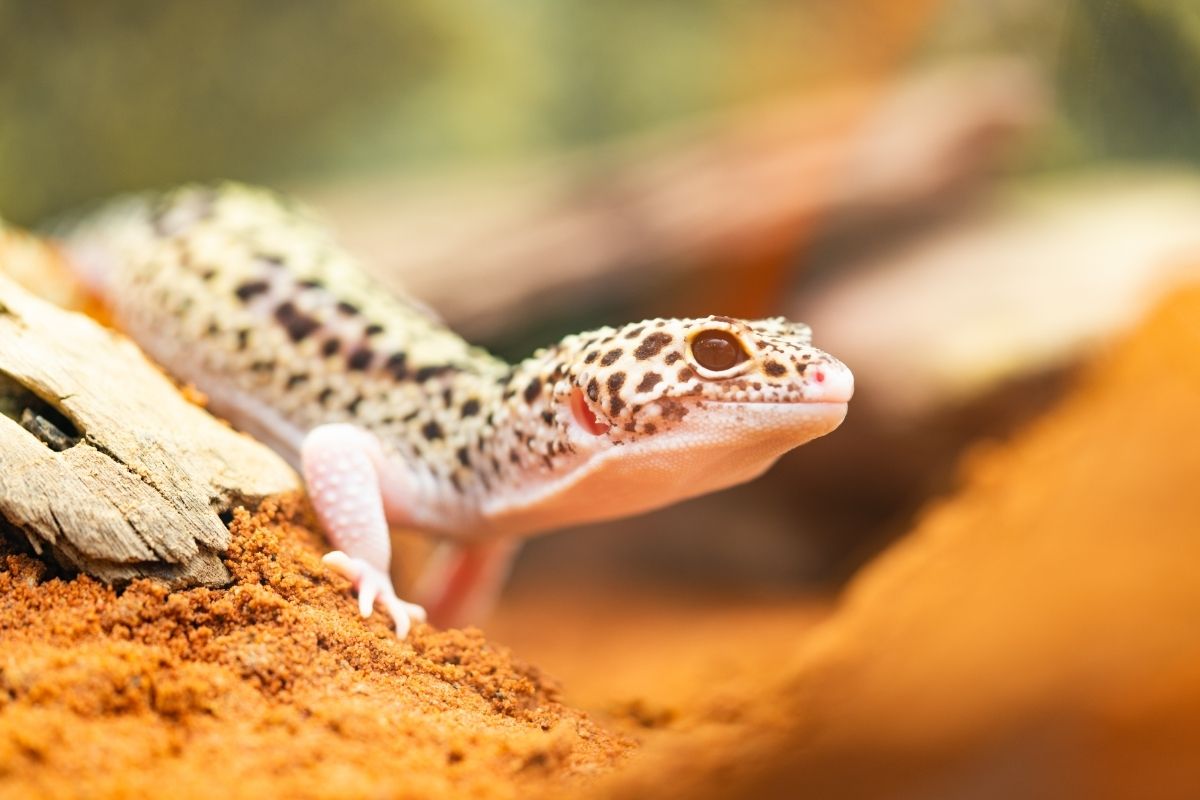Do you have a bearded dragon and a leopard gecko and are wondering if they can live in the same enclosure? Perhaps you have one of these animals and want to know if they would live well with a companion?
Or maybe you just want to know more about cohabiting! Whatever brought you here today, we have the answer for you!

When it comes to housing your pets, we know how difficult it can be to house them. You can quickly find yourself overrun with enclosures, with no space to turn your head.
So you wonder if you could cut down on them and pop a bearded dragon in with a leopard gecko. After all, animals travel in packs. Why wouldn’t they love it?
Well, we are here to tell you if you can put these animals together or not and everything you should consider. Just keep reading to find out more.
Can Bearded Dragons Live With Leopard Geckos?
Ideally, no, you should not keep your bearded dragon in the same enclosure as your leopard geckos. The main reason why you shouldn’t keep your bearded dragon in a home with leopard geckos is that they don’t get along very well.
The two species are both aggressive when kept together, which makes it difficult to keep them in harmony.
This means that you will probably end up having a lot of fights. As soon as you introduce the two species, they may start attacking each other.
This problem can become even worse if you try to mix their diets. Leopard geckos eat insects, while bearded dragons eat worms and small reptiles.
When you feed both species at once, it becomes impossible to tell what kind of food you are feeding them.
Another issue is that leopard geckos tend to be more active during the night as they are nocturnal, whereas bearded dragons are not nocturnal creatures; they are diurnal, meaning they are active during the day. Therefore, keeping either type of lizard together isn’t recommended.
The Different Housing Needs Of Leopard Geckos And Bearded Dragons
It is important to understand the differences between the housing needs of bearded dragons and leopard geckos which is another reason why they shouldn’t be kept together.
A bearded dragon requires a large enclosure, so you should consider getting a bigger tank than you normally use. You should also ensure that you provide a hideaway for basking, climbing, and sleeping.
Leopard geckos need a smaller enclosure since they aren’t as big as bearded dragons. Their habitat should include a hideaway for basing, climbing, and sleeping.
Leopard gecko cages should be smaller than those used for bearded dragons. They are generally less than 3 feet long by 1 foot wide. If you plan to keep your pet inside, you should place them in a room with a stable temperature (75-80°F) and low light, away from direct sunlight and drafty areas. It is also recommended to place a hiding spot, such as a cave or a box, for the gecko to feel secure and regulate its body temperature.
Bearded Dragons enjoy basking in direct sunlight. However, Leopard Geckos are nocturnal animals and prefer a cooler, low-light environment. Direct sunlight can cause overheating and stress for a leopard gecko, so keeping its cage out of direct sunlight is important.
Territorial Issues Between Bearded Dragons And Leopard Geckos
You shouldn’t keep your bearded dragon and leopard gecko together because of the territorial issues between the two species. Territorial behavior is normal among reptiles, but it can lead to serious complications.
When the two species fight over territory, it can result in injuries. In addition, this behavior can cause stress and anxiety in the lizard. These factors can make it harder for your bearded dragon to adjust to his new environment.
If you want to own a bearded dragon and a leopard gecko, you should keep them in separate enclosures. This way, you will prevent them from fighting and causing harm to each other.
Both Leopard Geckos And Bearded Dragons Can Carry Parasites
Bearded dragons and leopard geckos are both susceptible to parasites. Some of these parasites can be transmitted through contact with infected feces or urine.
If you have pets, you should take precautions against transmitting diseases such as ringworm and herpes simplex virus. Your pets should receive regular veterinary care.
Infected lizards can spread disease to humans and other animals. Therefore, you should always wash your hands after handling an infected animal.
You should keep bearded dragons, and leopard geckos separate to avoid them spreading diseases among each other.
Bearded Dragon Requirements

A bearded dragon requires specific conditions. He must have access to plenty of space, including a hideaway for basking, climbing, and sleeping, a hiding spot for nesting, and a safe area where he can rest.
He should also have a comfortable temperature, humidity, and lighting. A bearded dragon prefers temperatures around 70 degrees Fahrenheit. The ideal humidity level is about 80 percent.
He should have access to a variety of food items, including vegetables, fruits, insects, worms, crickets, and mealworms.
Your bearded dragon needs a reptile-safe diet that contains no additives like vitamins or minerals.
You should feed him a balanced diet that includes protein, carbohydrates, fats, calcium, phosphorus, magnesium, sodium, potassium, zinc, iron, copper, manganese, iodine, selenium, molybdenum, chromium, and cobalt.
Leopard Gecko Requirements

A leopard gecko requires similar living conditions to a bearded dragon. He should have a hideaway for basking, a hiding spot for nestling, and a safe area for resting.
His habitat should provide enough room for him to move around freely. He should have access to a large enclosure that has lots of plants and vegetation.
His enclosure should include a water dish, a hideaway for basking, and a hiding place for nesting.
He should have access to various types of food items, including fruit, vegetables, insects, worms, and crickets.
You should provide your leopard gecko with a healthy diet that includes protein, carbohydrates, fat, calcium, phosphorus, vitamin D3, vitamin B12, and essential amino acids.
How To Keep Them Separate
To ensure that your bearded dragon and leopard gecko do not get into fights, you should put them in different enclosures. This will help to keep them apart when they are awake.
When you first buy your bearded dragon and a leopard gecko, make sure you choose appropriate housing. If you purchase a bearded dragon from a pet store, look for one who provides good customer service.
Make sure you know how to properly care for your lizard. Ask questions if you need more information.
When you bring home your new pet, be careful not to let it out of its cage until you’re certain it’s happy and healthy.
Let Them Out At Different Time
If you want your bearded dragon and leopard gecko to coexist peacefully, you should never allow them to interact while both of them are awake.
This is because they may fight over territory and resources. They could even bite each other and cause serious injury.
Bearded Dragons And Leopards Geckos: What Are the Differences Between Them?
The main difference between a bearded dragon and a leopard gecko is their size. Bearded dragons are much larger than leopard geckos.
They grow up to four feet long and weigh anywhere from three pounds to eight pounds. Their bodies can range from orange to black.
Leopard geckos are smaller than bearded dragons. They usually measure less than two feet long and weigh only a few ounces. They come in many colors, including green, blue, yellow, red, brown, gray, and white.
In addition, bearded dragons are more intelligent than leopard geckos. They are also more likely to attack humans.
How Do I Care For My New Pet?
Once you’ve brought home your new pet, you’ll need to take proper care of it. It’s important to give your lizard a clean environment.
Clean his tank regularly by removing any debris or waste.
Keep your lizard’s tank well-ventilated, so he doesn’t suffocate.
Use a filter to remove impurities from the air. You should change your lizard’s water every week or two.
Feed Your Lizard Properly
Your lizard needs a balanced diet. Make sure you feed him a variety of foods, including fruits, vegetables, insects, and crickets. Avoid feeding your lizard too many treats.
Give your lizard plenty of space to roam around. Provide lots of hiding places.
Try not to leave your lizard alone for long periods.
Do Not Leave Him In The Dark
Lizards like to bask in the sun. However, this behavior can lead to overheating and heatstroke.
If your lizard becomes hot, place him in an area where there is cool, fresh air. You should also try placing him on a cooler surface.
Do Not Feed Your Lizard Too Much
Lizards eat about once per day. Remember to provide enough food for your lizard to eat throughout the day.
Avoid giving your lizard too much food at one time. He might become aggressive and start fighting with another animal.
Conclusion
Bearded dragons and leopard geckos both make excellent pets. They have similar personalities. However, they do differ in terms of size and intelligence.
If you would like to own both reptiles, make sure that you keep them in separate enclosures to avoid the risk of fighting.
